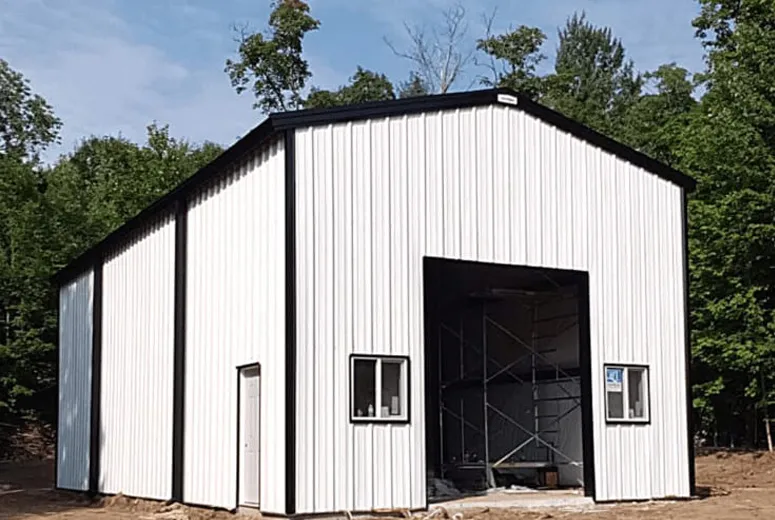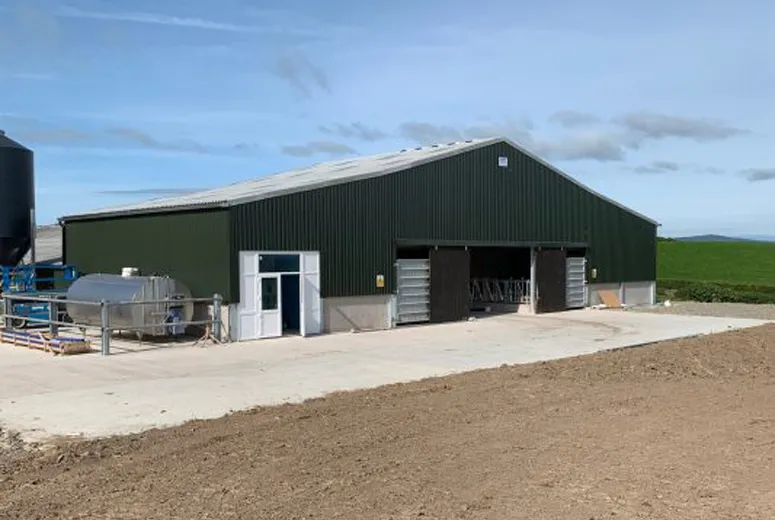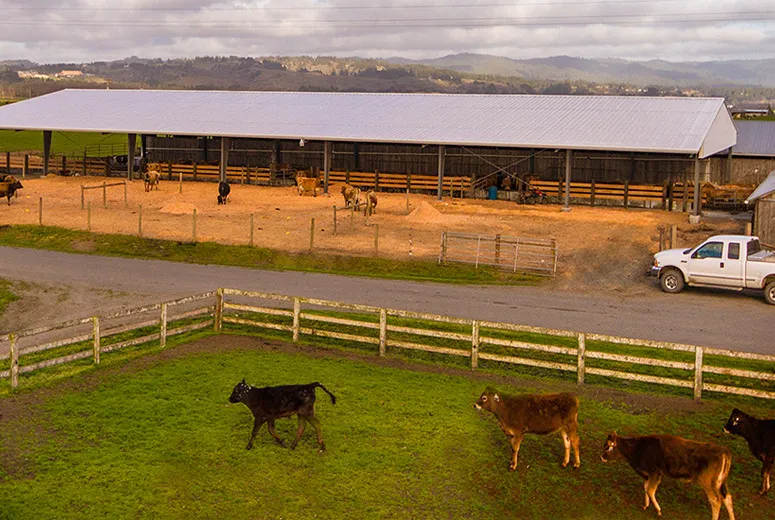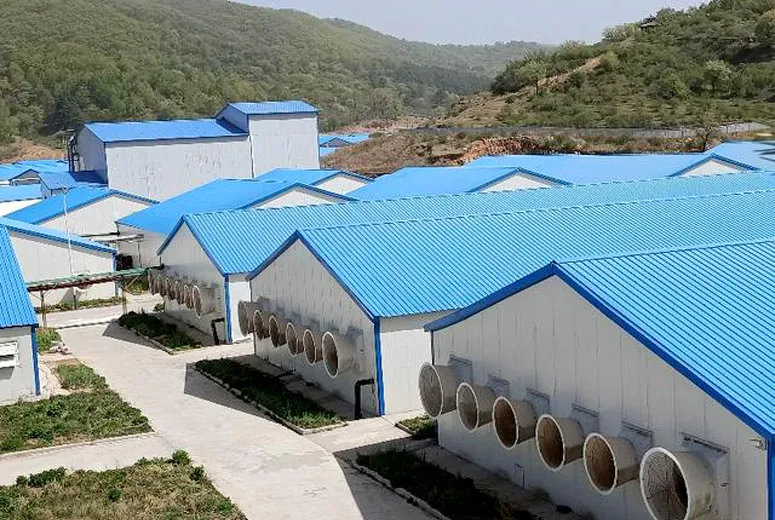Agricultural buildings are specialized structures designed to support farming operations, providing the necessary space for equipment storage, livestock housing, crop protection, and more. These agricultural steel buildings for sale are essential for improving farm productivity and ensuring the well-being of animals and crops.
1. Versatility in Design
Agricultural buildings are highly versatile, with customizable designs to suit a variety of farming needs. Whether it’s an agricultural barn for livestock, a greenhouse for crops, or a farm storage building for sale designed for equipment and grain, these structures can be tailored to meet specific operational goals. The layout can include large open spans, partitioned zones, and wide doors for seamless access.
2. Durability and Strength
Constructed from materials like steel, wood, or concrete, metal farm buildings are built to endure harsh environments including high winds, rainstorms, and snow loads. Steel frame farm buildings in particular are renowned for their resistance to rust, corrosion, and pests—offering long-lasting protection with minimal upkeep.
3. Energy Efficiency
Modern agricultural buildings incorporate energy-efficient features to reduce operational costs. Insulated panels, skylights for natural light, and proper ventilation systems help regulate temperature, ensuring a comfortable environment for both animals and crops while reducing energy consumption.
4. Livestock and Crop Protection
Agricultural buildings are designed to protect livestock and crops from extreme weather conditions and predators. For livestock housing, these buildings provide shelter, comfort, and security. For crop storage, they offer protection from pests and environmental damage.
5. Cost-Effectiveness
Agricultural buildings are generally cost-effective due to their simple design, low maintenance requirements, and the ability to expand as the farm grows. Prefabricated steel options are particularly economical and allow for quick construction with minimal disruption to farm activities.
In summary, agricultural buildings are essential assets for modern farming operations. They offer customizable, durable, and energy-efficient solutions to meet the diverse needs of farmers, helping to improve productivity and protect livestock and crops.
What is Another Word for Farm Building?
A farm building is a structure found on agricultural properties designed to support farming activities such as animal housing, equipment storage, crop protection, and more. While "farm building" is a commonly used term, there are several other words and phrases that refer to specific types of buildings on a farm, each serving a distinct purpose. These may fall under the broader category of agricultural buildings, which are essential to the operation of modern farms.
1. Barn
A "barn" is one of the most common alternatives to "farm building." Traditionally, barns are used for storing hay, grain, and farm equipment or housing livestock. They are often large, open structures with a high roof to allow for efficient storage and movement of goods.
2. Shed
A "shed" is another common term for a smaller farm building, often used to store tools, equipment, or machinery. Sheds can also be used for housing animals or storing crops. They are typically simpler in design than barns but serve similar functional purposes.
3. Stable
A "stable" refers specifically to a structure designed to house horses or other animals like cows. These buildings are usually divided into individual stalls, ensuring that animals are kept safe and secure.
4. Coop
A "coop" is used for housing poultry, such as chickens, ducks, or turkeys. These buildings provide protection from predators and provide a safe environment for the animals to lay eggs and roost.
5. Granary
A "granary" is a building used for storing harvested grains. Often found on farms that focus on crop production, granaries help protect grain from pests and weather conditions, ensuring it stays dry and safe until it can be sold or processed.
6. Greenhouse
A "greenhouse" is another specialized farm building used to grow plants in controlled environments. They are designed to regulate temperature and humidity, enabling the growth of crops regardless of external weather conditions.
In conclusion, while "farm building" is a broad term, alternatives like barn, shed, stable, coop, granary, and greenhouse each represent a distinct type of agricultural building tailored for specific farming functions. The rise of metal farm buildings and steel farm sheds further underscores the shift toward more durable and efficient building solutions in agriculture.
What is a House Built on a Farm with Buildings Around It?
A house built on a farm with buildings around it is typically referred to as a farmhouse. It is the central residential structure on agricultural land, serving as the main living space for farmers and their families. Surrounding the farmhouse, you’ll often find a variety of agricultural buildings designed to support different farming operations.
Farmhouses are traditionally designed to be functional and practical, providing a comfortable living space while allowing for proximity to the working areas of the farm. In addition to the residential area, a farmhouse may include rooms for storage, kitchens designed for food preservation, and living areas for family members. Historically, farmhouses were often large, built with durable materials like wood or brick, reflecting the need for both shelter and stability in rural areas.
Around the farmhouse, agricultural buildings are strategically placed to support various farming activities. For example, barns are used for housing animals or storing crops, sheds provide storage for tools and machinery, and stables may be used for housing horses or livestock. These buildings are essential for farm operations, and their placement around the farmhouse allows farm families to manage their work efficiently.
In modern times, farmhouses have evolved, blending traditional and contemporary elements. Some farmhouses are now equipped with modern amenities, while still maintaining a connection to the agricultural lifestyle. The design of a farmhouse and its surrounding buildings often reflects the specific needs of the farm and can vary depending on the size and type of farming operation.
In summary, a farmhouse is the central living structure on a farm, surrounded by various buildings that support agricultural activities. These homes combine practicality and comfort, offering a foundation for the day-to-day operations of farm life.
Reliable Agricultural Buildings for Sale
Investing in agricultural buildings for sale is a critical step for farmers who seek longevity, versatility, and cost-efficiency in their operations. At Hebei HongJi Shunda Steel Structure Engineering Co., Ltd., we understand that no two farms are alike—which is why our steel-framed agricultural buildings are never one-size-fits-all. Since 2000, our company has specialized in the design, manufacture, and installation of durable steel structure solutions for a wide variety of agricultural uses, from crop storage to livestock housing. With a manufacturing base that spans 52,000 square meters, we bring decades of experience and an unwavering commitment to quality into every project.
Our customers often come to us seeking farm buildings for sale, but they leave with more than just a structure. What we offer is a complete, customized solution that aligns with the specific environmental, logistical, and economic needs of each farm. Whether you require a large-scale warehouse for grain storage, a secure shelter for expensive equipment, or a modern barn for livestock care, we have the expertise and capacity to deliver. Our agricultural buildings are engineered with high-tensile steel and constructed to withstand challenging climates, ensuring year-round usability.
What sets us apart is our commitment to integration. From design to on-site installation, our professional teams work closely with you to ensure every detail is optimized for performance and durability. In a market saturated with generic agricultural steel buildings for sale, we offer a personalized experience backed by consistent quality control, sustainable building practices, and long-term customer support. We also prioritize cost-effective procurement of raw materials, which allows us to keep pricing competitive without sacrificing quality.
More than just physical structures, our buildings are built to support the future of agriculture. Whether you're expanding your current setup or transitioning to modern steel infrastructure, our agricultural buildings for sale stand as reliable, long-lasting investments that enhance productivity while reducing operational stress. It’s this philosophy—detail-oriented, customer-focused, and environmentally responsible—that has helped us become a trusted partner for agricultural professionals across regions.
Exploring Types of Agricultural Building
In the evolving world of agriculture, the need for specialized and efficient infrastructure has never been more urgent. At Hebei HongJi Shunda Steel Structure Engineering Co., Ltd., we’ve spent over two decades responding to this need by developing a wide range of agricultural building solutions tailored to real-world farm environments. From our state-of-the-art production facility, we deliver diverse building types that address everything from equipment storage to animal welfare, integrating strength, space, and sustainability in every structure we create.
One of the most commonly requested structures is the steel-framed agricultural barn, which plays a critical role in animal husbandry. These buildings are not only designed for durability but also feature layouts that enhance animal movement, ventilation, and sanitation. In colder climates, they can be insulated to improve livestock comfort, while in warmer areas, airflow and natural light become primary considerations. Our barns are built to meet these unique challenges without compromising structural integrity or usability.
Another essential type is the agricultural steel shed, which offers ideal protection for heavy-duty farming machinery and tools. Unlike traditional timber-framed storage units, our steel structures are engineered for long-term resistance to rust, pests, and moisture. Farmers operating with high-value equipment often prefer these sheds for their security and minimal maintenance needs. We also cater to operations that require multipurpose agri sheds, capable of housing storage on one end and a workshop or processing space on the other.
Beyond livestock and machinery, we provide solutions for grain storage, chemical handling, and even administrative spaces. Every agricultural building we manufacture follows a rigorous design process that begins with customer consultation and ends with expert on-site installation. This integrated workflow allows us to meet specific spatial, structural, and budgetary requirements without delay or deviation. Our in-house design team collaborates with clients to create tailored floor plans, while our installation teams ensure seamless assembly in the field.
What makes our building types so effective is the shared foundation of quality and flexibility. No matter the size or function of the structure, we uphold the same standards in material selection, fabrication, and post-installation support. Farmers who choose our buildings are not just buying a frame—they’re investing in infrastructure that grows with their business. From agricultural barns for sale to modern hybrid steel sheds, we are proud to provide solutions that serve the future of farming.
Understanding Farm Shed Costs Clearly
The question of farm shed costs is often more complex than it appears on the surface. While many manufacturers offer a baseline quote per square meter, such estimates rarely reflect the full picture. At Hebei HongJi Shunda Steel Structure Engineering Co., Ltd., we believe that clarity and transparency are essential in helping our customers make informed investment decisions. Having designed and installed thousands of steel agricultural structures since our founding in 2000, we’ve developed a clear understanding of the variables that influence cost—and how to optimize them.
The primary driver of cost is design. A simple open-air shelter will naturally cost less than a climate-controlled, insulated facility with segmented storage zones and reinforced flooring. Yet design isn't just about aesthetics—it's about maximizing functionality. Our team works directly with clients to assess operational needs, whether the shed is meant to house hay bales, tractors, or delicate equipment. Clients searching for steel farm sheds for sale benefit from our ability to customize every dimension and feature of their structure, ensuring that no square meter goes to waste.
Material choice also plays a pivotal role. We utilize high-strength, galvanized steel that stands up to environmental stressors over time. While the upfront cost may be higher than timber or aluminum alternatives, the long-term value is indisputable. Reduced maintenance, lower repair frequency, and improved security make our steel sheds a cost-efficient option for serious agricultural operations. For farmers looking at farm machinery sheds for sale, we also include design enhancements such as wide-span entrances, roller shutter doors, and integrated lighting systems to support safe and efficient use.
Labor and logistics are two additional factors that impact pricing. Unlike many providers who subcontract different stages of the build, we offer end-to-end service from planning to on-site assembly. This approach reduces miscommunication and delays while helping to keep costs in check. Our installation teams are highly trained and capable of working in varied terrain and weather conditions, ensuring smooth and timely delivery.
Ultimately, the real cost of a farm shed lies in how well it performs over time. A cheaper structure that requires frequent repairs or fails under extreme weather is far more expensive in the long run. That’s why we emphasize value over mere pricing. By choosing Hebei HongJi Shunda, clients gain a partner who understands not only how to build durable farm infrastructure, but how to do so with precision, cost-efficiency, and long-term support in mind.

















